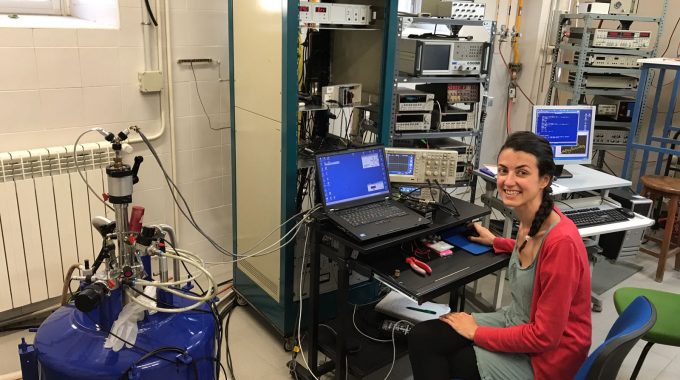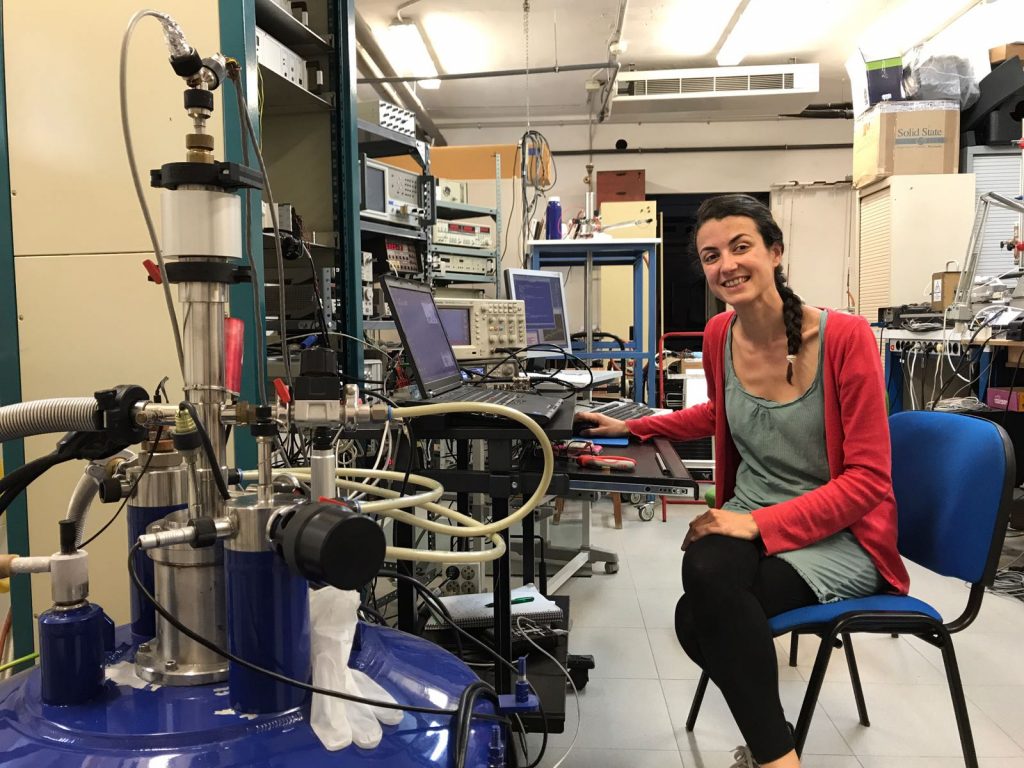
“Fundamental research allows us to understand better the world we live in”, Pepa Martínez-Pérez
Pepa Martínez-Pérez (Spain, 1983) has been working and developing SQUID for many years. It all started in her Ph.D. when she collaborated with Physikalisch Technische Bundesanstalt (PTB) Berlin, one of the leading centers at the forefront of SQUID sensor research. Today, she works as a senior researcher at the Institute of Nanoscience and Materials of Aragon (INMA), a joint between the Spanish National Research Council (CSIC) and the University of Zaragoza in Spain. Last year, she received a Starting Grant from the European Commission to build her own research group focused on superconducting circuits and small magnetic systems.
Q. How are you handling the start of your own research group?
A. My project will start very soon in September 2021, so now, I am trying to build up my new laboratory. I am hiring researchers and I have just acquired a new dilution refrigerator that will arrive hopefully soon. This refrigerator will allow me to reach a few mK above absolute zero, where quantum properties of magnetic and superconducting circuits will show up. Such low temperatures are something very special, I think the only thing in which humanity has overcome nature is the low temperatures we have achieved in the laboratories.
So, once I get this low-temperature refrigerator, my team, and the set-ups, all will be ready to start measuring. For now, we have only performed, with the help of some colleagues, simulations and theoretical works of the experiments we would like to try.
Q. What will your research be about?
A. My project is called QFaST and the goal is to study quantum properties of small magnetic systems using superconducting circuits as sensors also called SQUIDS. That’s why, first of all, we need to build up a sensor SQUID based on superconducting materials and Josephson junctions, to then start observing, thanks to the SQUID system, the spin fast dynamics in magnetic materials.
From what we observe, a spin wave is simply a kind of electromagnetic wave or a sound wave but made of modulations of magnetization. This happens in magnetic materials, and when you go down to the quantum level, these spin waves made of magnetic modulations become quantize, as everything in nature, and can be manipulated ideally and observed at the quantum level. My goal is to explore the properties of this quantum of spin-wave, using the SQUIDS to measure them, as this may have an application or might be useful for quantum technologies.
Q. What is exactly a spin-wave?
A. The spin-waves or magnons are very similar to the phonons. Phonons are vibrations of atoms around the position they normally occupy, and magnons occur in materials in which each atom carries a small magnet. Magnons are small modifications of the orientation or strength of these small magnets that propagate through the solid as a wave.

Q. What kind of applications?
A. Well, magnonics are up to now mostly studied for information applications, but not for quantum computing applications. For instance, something that I am very excited about is trying to connect the production of these spin waves, these magnons, with quantum circuits to link these two fields: superconducting quantum computing and magnons. Around five years ago, some groups started to study magnons also in the context of quantum information. So this is a very recent research field.
Q. How would these magnons operate in the context of quantum computation?
A. The actually developed quantum computers by these big companies that we all know are almost based on superconducting qubits. In his computers, the superconducting qubits are immersed in what is called a resonant cavity. This is just a system that allows the operation of practical qubits. Thanks to these resonating cavities, you can communicate qubits, you can read them, you can store information in them and retrieving the information or you can perform also gate operations, like in a conventional computer.
The novelty of the magnons is about merging this superconducting architecture, which I just described, with a magnetic system. In this magnetic system, information can also travel between quits but in the form of spin waves or magnons. The magnons are quasi-particles that can transmit information without heat dissipation. So this is very efficient from an energetic point of view and the reason why researchers are interested in this application.
Q. Are there any other applications that you find interesting?
A. These magnonic systems could, in principle, interact very nicely with dark matter. As you may know, in the universe there is a considerable amount of material that we cannot understand, the so-called dark matter. There are different candidates that scientists believe could be part of this dark matter, but there is still no certainty (for instance wimps and axions). Interestingly, when axions traverse these magnetic materials, they should leave a fingerprint. So, I would like to try to develop sensors based on large amounts of magnetic materials that are connected to a superconducting circuit that allows me to read the fingerprints.
There are many other applications that come to mind, but I would like to point out that my research is very fundamental. The general public usually expects direct and fast applications of science in their daily lives, but fundamental research works differently. This type of research takes many years, through different research groups, until a possible application comes out. Of course, there are also examples in which fundamental science has led to very fast applications like the effect of Giant magnetoresistance (GMR), a phenomenon that was discovered in 1988 by the Nobel Prize Albert Fert and in just 10 years, a record time, the GMR was implemented into computers in the form of magnetic memories. But there are other times and usually most of the time in which fundamental research never leads to any applications. However, I believe that fundamental research always allows us to understand better the world we live in, which I think is something beautiful.
Author: Lucia Torres @osopolita_
